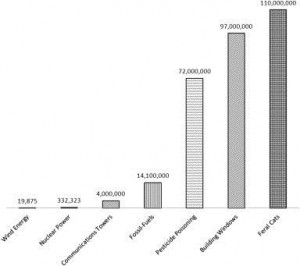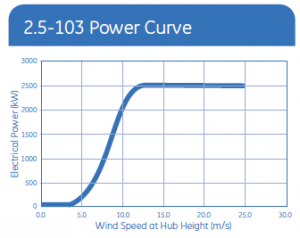Hate Windows, Not Wind Turbines
Windows kill over one hundred million birds each year in the United States alone, that’s over ninety nine million nine hundred and eighty thousand more than wind turbines, yet you don’t see people protesting the use of windows.1
In fact, a study conducted by the AWEA in 2006 concluded that less than “0.003% (3 of every 100,000) of bird deaths caused by humans and pets” is caused by wind power.2 A study published in Renewable Energy: An International Journal states that “wind farms . . . are responsible for between 0.3 and 0.4 fatalities per gigawatt-hour (GWh) of electricity while fossil fueled power stations are responsible for about 5.2 fatalities per GWh.”1
Figure 1 below shows that wind energy is not even competing with the leading causes of bird deaths. Topping the chart is feral cats, followed closely by windows.
Birds aren’t the only flying critters being affected by the furious spinning weaponry known as wind turbines. Bats are having a similar issue with avoiding the deathly blades. But its not just running into the blades that kills bats. The main issue for this mammal is lung explosion: “bats die in the blade vortices. Rotating turbine blades create negative pressure pockets, and when the bats fly through them, their lungs explode.”3 This kills hundreds of thousands of bats per year. So even though turbines have virtually no effect on birds they do have a major effect on the bat community. It is estimated that in one fall migration a single wind farm can kill hundreds of thousands of bats.3
Engineers and scientists have found that there is a simple fix to save the lives of 93% of possible bat fatalities. Merely increase the cut-in speed of turbines from their usual 8 or 9 miles per hour (mph) to 11 mph. They also concluded that this increase in cut-in speed would result in less than one percent power loss.3 This makes sense.
Let us use New York, a place where thousands of bats are killed by wind turbines, to go over a few scenarios. In New York the average wind speed around a wind farm is about 7 meters per second (mps), 15.6 mph. Now if we the wind speed will be above 11 mph 84 percent of the time, and above 9 mph about 91 percent of the time. The power curve below for the GE 2.5-103 shows that this typical wind turbine has a cut-in speed of 6.7 mph. The power generated at that speed is very minimal. At 11 mph (about 5 mps) the power generation is still relatively low.
At 15.6 mph (about 7 mps) the power production is significantly greater, around 1200 kW. Now we look at the area under the curve from the cut in to 11 mph which is about 602688 kWh. The work at the average wind speed is 10.5 million kWh. This shows a 9% loss in work production which is greater than the claim of 1 percent but still relatively low. So, we can save the lives of tens of thousands of birds and bats by only sacrificing less than 9% of the power generation.
All in all, there should not be a soul on earth that thinks wind turbines kill too many birds, especially with the simple fix that is most likely being put into place. At least in New York where the study was done.
Work Cited
1The Avian Benefits of Wind Energy: A 2009 Update, Renewable Energy: An International Journal
2American Wind Energy Association: Energy and Wildlife
3Increasing Wind Turbine Turn-On Speeds Could Help Reduce Bat Deaths, Popular Science
Wind Energy Development Environmental Concerns

